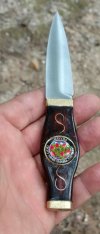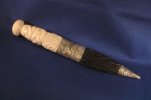You can make the pommel cap with a bezel extending up from it. Set the cabochon in the bezel with slow setting epoxy and work the bezel down tight against the stone. If you are good with a jewelers torch, this works fine.
The simplest way to do a cabochon ended handle is:
Start by making the handle. It should end in the shape of the desired cabochon. If working from a pre-made cabochon, a good trick is to glue the cabochon on the end of the handle blank and shape until the butt is flush with the stone. Do all work on the handle.
Make a 3/4" high cylinder of malleable metal - silver, copper, brass, or nickel silver work fine. If you can't silver solder well, use a ring cut from pipe. Copper plumbing pipe will work great, and can be hammer worked easily. See tip below*.
Put the cylinder on a steel tapered mandrel and work it until the cylinder slightly tapered.
Remove from the mandrel and shape it by hand to the shape of the handle. Make it fit the handle so 1/4" of the bezel is sticking past the wood and over the sides of the stone. Trim the bezel to the length and shape so it looks right. You want the bezel to come up about 1/4 of the stones height ( but that can vary depending on stone shape and size).
After the look and fit is good, apply 5 minute epoxy to the wood at the handle butt, set the stone on the butt ( if it is not still glued in place) and push the bezel on tight. Put the resin on the wood only, and not up on the stone. Clamp/hold in place while the epoxy sets. You can clean off excess while it is gelling with denatured alcohol. Once set, clean off any excess resin and you can add a few decorative round head brads for security, or just leave it glued in place.
Using a burnisher, work the exposed bezel down snug on the stone.
Use a very fine steel wool or 3M polishing papers to buff up the bezel and handle.
Because I cut my own cabochons to fit, I usually make the handle and blade first, and then when they are fitted and sanded as much as they will get, I fit the bezel and stone. If you are working with a purchased cabochon, you have to make the handle butt match the stone shape, so gluing it on the end while you finish shaping and sanding the handle is a good idea.
TIP *
Copper pipe is great for making ferrules, butt caps, and sword fittings. It can be soldered to plates of metal with easy silver solder ( high temp, not the low-temp soft stuff).
Copper pipe comes in several grades, with M and L being the ones readily available. M is the thin stuff for piping homes. L is heavier gauge and much thicker. It is the type best used for making knife fittings. Ebay is the place to buy short pieces of copper pipe. I suggest getting a foot or so of 1/2", 3/4", and 1" for making fittings. If making collars, throats, and tips for scabbards, you may even want 1.25". Cut the pipe with a hack saw or on the metal cutting band saw. Sticking a wooden dowel in the pipe when cutting makes it easier to control.
Copper needs to be annealed to work it. Hammering on it will harden it, and it will need to be re-annealed regularly. Just heat copper to a dull red glow and quench in water. That will return it to dead soft. Copper takes on a great look when hammer worked with a ball faced hammer. take a small ball peen hammer and grind the ball down to be a less pointed curve. Sand to 400 grit and polish the face. The shinier the face, the smoother the dimples left by it. Once the copper is about 75% shaped to the desired size, start working it with the ball faced hammer. This will continue to stretch the fitting. Obviously, you want to be working on a steel mandrel. The mandrel does not need to be the exact shape of the final fitting, but it is nice if it is close. You can shape the fitting to the final size after the last annealing.
To clean the copper up, soak in pickle for a short while. Pickle is a term for an acidic solution to remove oxides from metal. There are many commercial pickles, like Sparex, but a couple tablespoons of Ph-Down in a quart of water works fine. Freshly pickles and then buffed with steel wool will make the copper shiny golden color. However, patina will soon form and make it the reddish color we all know as copper.
To darken the fitting to a wonderful look - after all work, shaping, pickling, sanding and buffing is done - use a solution of Livers of Sulfur to get a great silvery black look. Soak the fittings in the solution for as long as needed to turn black ( I leave them for several hours), wash off and rub with the finest steel wool you can get, wash well to remove all oils from your hands and the steel wool, and soak again in the solution. Repeat until it has that wonderful glowing look of aged silver fittings or Japanese shakudo. This black look will last almost forever.






